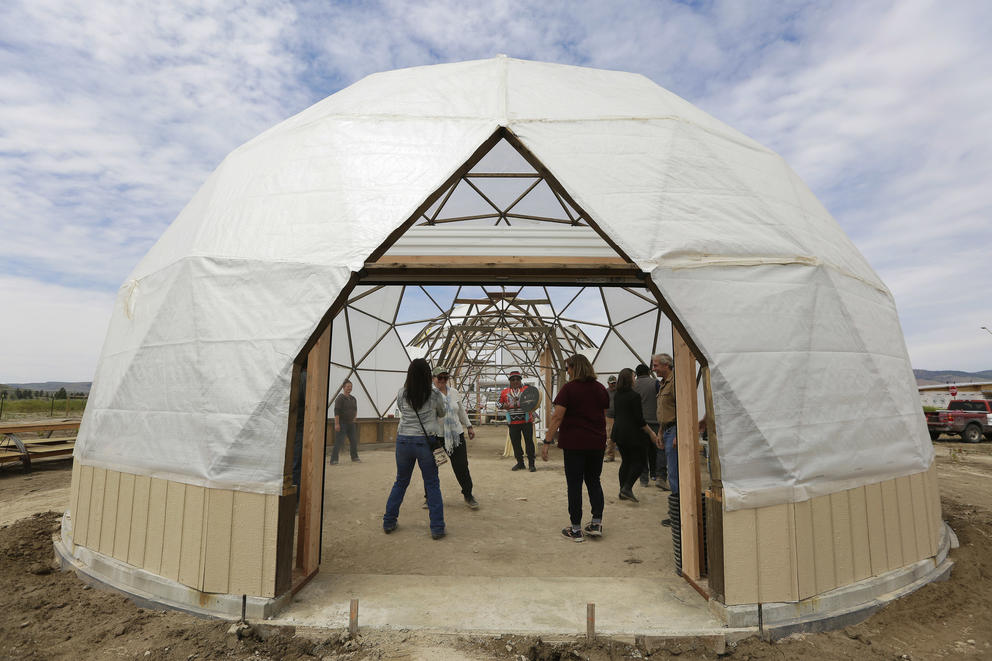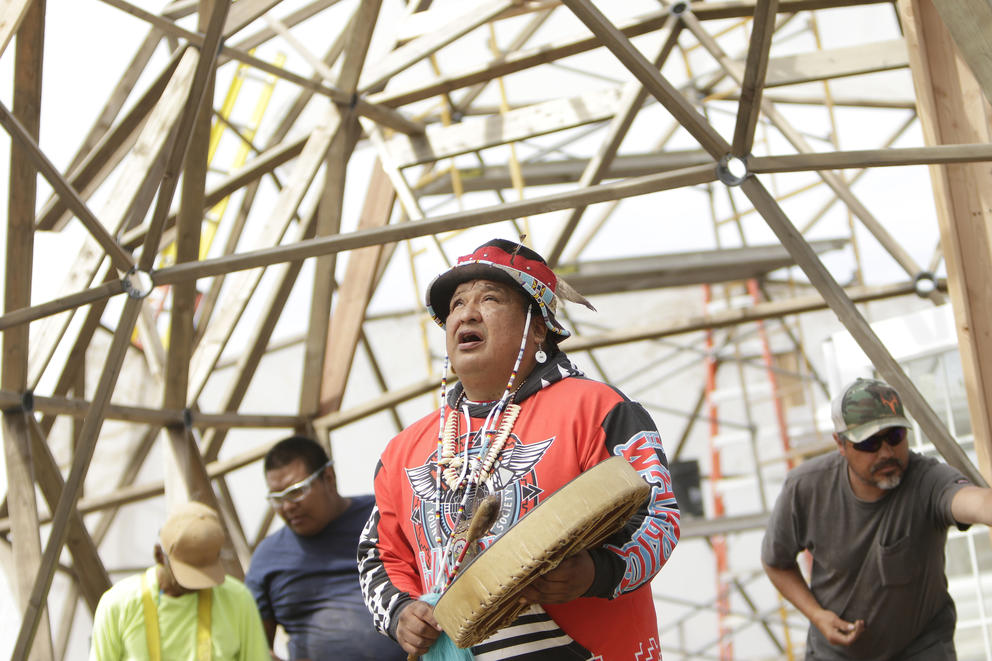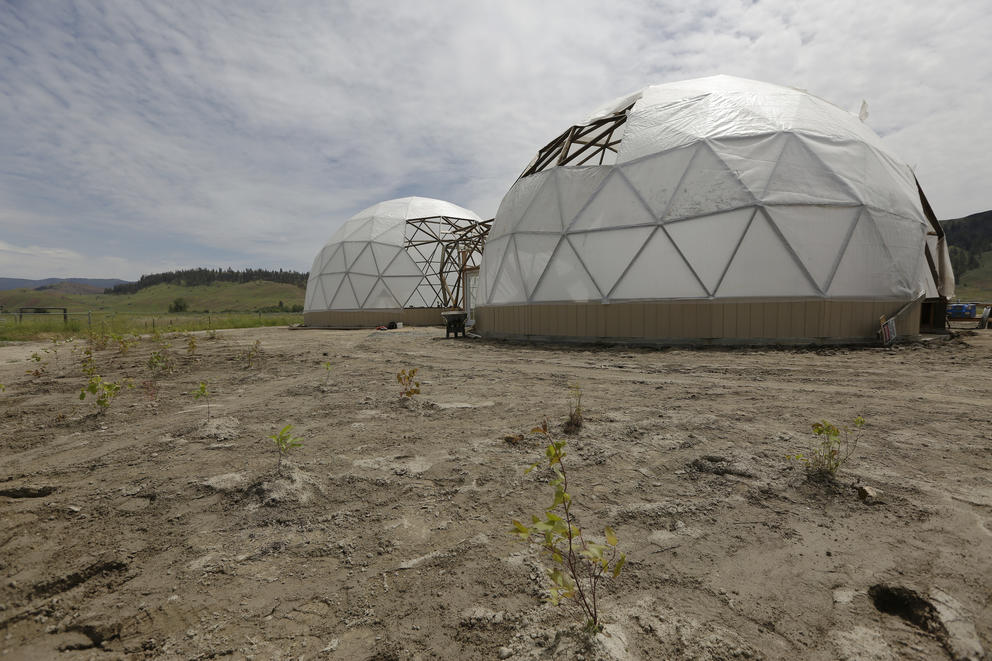The domes consist of 20 straight sides that create half-balls that are almost 20 feet tall and 35 feet in diameter. They each make room for roughly 1,000 square feet of crop space to grow a variety of vegetables and flowers, spread out horizontally and stacked on shelves vertically.
This story is published in partnership with the Energy News Network, a nonprofit news organization that covers the transition to clean energy.
These compact growing spaces also leave room for solar energy to grow outside. An adjacent two rows of solar panels will be capable of producing up to 20 kilowatts of electricity a year.
The solar cells will provide electricity to heat and run the watering equipment for the domes. The food and surplus electricity will go directly to nearby homes. And the planning and execution of this so-called agrivoltaic project will be an example to be spread across the grid to planners, farmers and engineers interested in learning more about this new way of using farmland to grow both food and electricity at the same time.
“The community is very excited about it,” said Tauni Bearcub, the project’s manager for Konbit (pronounced “kone-beet”), a Boulder, Colorado, company specializing in food-growing programs with an emphasis on Native American lands. She is also a member of the Colville nation.
Dan Nanamkin, director of Young Warrior Society, center, leads a prayer for the land inside a geodesic dome under construction during an opening ceremony at a micro-farm, a collaboration between the Confederated Tribes of the Colville Reservation and Konbit, that includes geodesic domes and solar panels for agrivoltaics, Wednesday, June 15, 2022, in Nespelem, Wash. (Young Kwak for Crosscut)
The project is due to be ready by July — less than a month after President Joe Biden ordered emergency measures to boost supplies to U.S. solar manufacturers and declared a two-year tariff exemption on solar panels from Southeast Asia. This will be Washington’s first venture into agrivoltaics, the mingling of solar-power panels with growing crops.
The idea of agrivoltaics first surfaced in 1981 in Germany as a proposal by scientists Adolf Goetzberger and Armin Zastrow that solar panels and agriculture can share the same land to make it more profitable. The concept took off about 10 to 12 years ago as the costs of solar power dropped. This practice, also known as agrophotovoltaics in Germany and solar sharing in Asia, remains more common in Europe than in the United States.
In the United States, agrivoltaics has gained toeholds mostly east of the Mississippi River while also popping up in Arizona, Colorado, Oregon and now Washington in the West.
“The East Coast has been a little more proactive on this one,” said Chad Higgins, an associate professor in the biological and ecological engineering department at Oregon State University.
Agrivoltaic sites are small. Jordan Macknick, lead energy water and land analyst at the National Renewable Energy Laboratory in Golden, Colorado, estimated that crops and solar panels jointly use only about 50 acres of land nationwide. The Nespelem site is about one-third of an acre.
Macknick said agrivoltaics does not appear practical for farms with hundreds and thousands of acres, but these projects are more appropriate to install on a small scale. “The sweet spot is 20 acres or less,” he said.
There are three types of agrivoltaic ventures. The first is solar panels among crops. Second is grazing by sheep or other animals munching grass in the shade of solar panels, which can be found in New York and Minnesota.
The University of Minnesota installed 30 kilowatts’ worth of solar panels on a dairy farm in 2018 to conduct a 2019 study on how the cows interact with the solar panels. That study determined that the cows sought the shade of the solar panels, causing them to graze less. The university plans follow-up studies on the cows’ reproductive performance plus the long-term effects on their health, milk, fat, and protein production, as well as weight and body condition.
The third type of agrivoltaics involves flowers, in which bees wander around the solar panels collecting pollen to make honey. Such projects can be found in Vermont, Minnesota, Illinois and Wisconsin.
The hair-care company Aveda keeps beehives on its campus in Blaine, Minnesota. It added a 900-kilowatt array of solar panels to the field of flowers used to generate electricity for its campus.
National acreages on the grazing and beekeeping agrivoltaics are not available.
Solar panels and farming flourish best on the same types of level, loose soil that accommodates both crops and steel beams. Even with growth in agrivoltaics, the need for clean power is likely to increase tensions over rural land use in many places. Estimates for the amount of land required to meet Biden’s 100% clean electricity goal by 2035 range from an area bigger than Delaware to a footprint the size of South Dakota.
“There’s going to be massive pressure on agricultural lands from solar,” Higgins said last September at a Washington State University Extension Service video conference in San Juan County on agrivoltaics. Higgins did not respond to several email and phone requests for an interview. San Juan County farmland — which is also very expensive real estate — has been steadily shrinking in recent years, and he offered agrivoltaics as one answer to that challenge.
Agrivoltaics requires a delicate balancing act among sunlight, costs, solar panels and crops. The solar portion and the crops portion have a very complicated relationship.
A major challenge comes in deciding what crops will be grown. There are limits on the height — usually six to eight feet — of the solar panels, which translates to how much expensive steel must be used. The height and angles of the panels affect the shade and sunlight reaching each row of crops. It’s worth noting that not all crops need sunlight all day, and some do better when shaded some of the time. The space between the rows of solar panels must accommodate the biggest piece of farm equipment to be used. Another wrinkle is that the types of crops may change from year to year.
“For the most part, the solar part of the equation is much more straightforward,” said Macknick of the National Renewable Energy Laboratory.
“Ag needs to adapt to whatever solar array is there,” said Byron Kominek, a co-owner of Jack’s Solar Garden of Longmont, Colorado, which has four acres of solar panels and works closely with the lab.
Makoti Fox, the lead in discussions about the micro-farm project with the Tribal Council, right, speaks inside a geodesic dome under construction during an opening ceremony for the collaboration between the Confederated Tribes of the Colville Reservation and Konbit, that includes geodesic domes and solar panels for agrivoltaics, Wednesday, June 15, 2022, in Nespelem, Wash. (Young Kwak for Crosscut)
One universal truth appears to be that the generation of electricity is the bigger and more reliable money-maker on these farms. Macknick estimated that the electricity sales from a site could reach up to twice as much as the crop sales.
Another complicating factor is regulations. Agrivoltaics combines industrial and agricultural rural land uses, a concept that does not fall neatly into zoning regulations almost anywhere. Macknick and Higgins said land-use rules vary from county to county.
When Jack’s Solar Garden, which produces 1.2 megawatts of electricity a year, was first proposed five years ago, its host county would allow only 100 kilowatts to be produced on its farmlands, so they had to get the local zoning rules changed.
Insurance is another headache, with competing priorities from usually separate entities: Developers want a restricted site, while farmers want easy access. Oregon State University is just opening an experimental agrivoltaics farm with many different governments and owners involved.
“The insurance conversations were spicy. Who is liable for what?” Higgins said, adding that the attorneys “ran through months and months and months of ‘what if’ solutions.”
In the video conference, Higgins noted that a major obstacle to deploying electric cars in great numbers is their limited range coupled with the lack of rural charging stations. Strategically placed agrivoltaic farms could serve future rural and interstate highway charging stations, he speculated.
Enter Konbit, whose projects include extremely small farms, including the agrivoltaic operation in Nespelem. “If you grow food on microfarms, why not add photovoltaics?” said Konbit founder Sanjay Rajan.
Rajan is a longtime Colorado entrepreneur specializing in financing small ventures such as boosting textiles being produced in India and providing food for the poor, especially Native Americans. Originally an engineer, he has M.B.A.s from Columbia University and the London Business School.
A geodesic dome under construction. The domes consist of 20 straight sides that create half balls that are almost 20 feet tall and 35 feet in diameter. They each make room for roughly 1,000 square feet of crop space to grow a variety of vegetables and flowers, spread out horizontally and stacked on shelves vertically. (Young Kwak for Crosscut)
Rajan brought in Hugo Grisetti, a longtime architect of geodesic domes from Brooklyn, to design the Nespelem domes.
The Colville nation does not have an energy department, and Konbit is not connected to Nespelem Valley Electric Co-Op. The $100,000 Nespelem project is being paid for with federal grants. A $48,000 annual National Renewable Energy Laboratory grant will be used to gather data from the Nespelem project for three years. The actual annual operating budget still needs to be pinned down. “It’s a prototype. We don’t know yet,” said Konbit’s Bearcub.
The Colville reservation is divided into four districts, and Bearcub hopes to eventually install one set of domes in each district.
Macknick said of the Nespelem project, “We’re hoping it will be a model to really expand.”
Correction: The solar panels installed as part of the Colville agrivoltaics project will produce up to 20 kilowatts of power. An earlier version of this story used an incorrect unit of energy.









